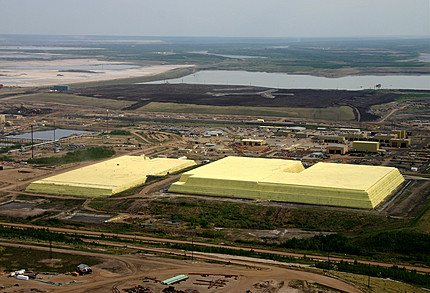NEW view various maps at Geohack:
TinyURL.com/GreatSulfurPyramidsOfAlberta
The other way is by creating synthetic crude by using "Upgraders"
(aka Cokers aka Crackers) which "crack" the very long hydrocarbon
molecules into smaller lighter more useful liquids, like wax, diesel, fuel oil, naptha,
http://www.calgaryherald.com/business/energy-resources/Suncor+Energy+Voyageur+oilsands+upgrader/8160850/story.html
2: It is extremely energy intensive. So much so the net energy might be near zero*. (EROI=1). Heinberg of PCI quotes the EROI of Syncrude at between 7:1 to 1.5:1.
http://www.ifg.org/pdf/Searching%20for%20a%20Miracle_web10nov09.pdf
3: It produces "a lot" of waste. Check Google images for "Suncor Sulfur". They've get a few giant piles of it which are roughly the size of the Great Cheops Pyramid in Egypt. I calculate it's about ~6M cubic meters, and 12M tons of sulfur. A 1 mile train of 100x 100ton hopper cars holds 10,000 tons. so 12 Million tons would be a train of sulfur 1,200 miles long. (Chicago to Tampa)
NO, NOT GOLD!
These are the Great Sulfur Pyramids of Alberta, a waste product of Tar Sands development.
If you loaded this on to a train of 100 ton hopper cars, it would stretch 1,200 miles, from Chicago IL to Tampa FL.
To get a sense of scale, locate the puddle of blood-red liquid on the top of the pile in the right.
Do you see it? The object next to it is a double-length tanker truck. A single-length truck is 53',TinyURL.com/GreatSulfurPyramidsOfAlberta
There are two ways to ship tar sands.
One is by creating diluted bitumen, "Dilbit", by adding
dilutent (NGLs) which must be shipped in to the area.
One is by creating diluted bitumen, "Dilbit", by adding
dilutent (NGLs) which must be shipped in to the area.
This is because the source bitumen (aka tar or asphalt)
is so sticky and thick it cannot be transported by a normal pipeline.
is so sticky and thick it cannot be transported by a normal pipeline.
The other way is by creating synthetic crude by using "Upgraders"
(aka Cokers aka Crackers) which "crack" the very long hydrocarbon
molecules into smaller lighter more useful liquids, like wax, diesel, fuel oil, naptha,
kerosene, and gasoline.
However there are three problems with this.
1: It is extremely capital intensive. Suncor was looking at a bitumen upgrader which would have cost $11.6 Billion:
1: It is extremely capital intensive. Suncor was looking at a bitumen upgrader which would have cost $11.6 Billion:
http://www.calgaryherald.com/business/energy-resources/Suncor+Energy+Voyageur+oilsands+upgrader/8160850/story.html
2: It is extremely energy intensive. So much so the net energy might be near zero*. (EROI=1). Heinberg of PCI quotes the EROI of Syncrude at between 7:1 to 1.5:1.
http://www.ifg.org/pdf/Searching%20for%20a%20Miracle_web10nov09.pdf
3: It produces "a lot" of waste. Check Google images for "Suncor Sulfur". They've get a few giant piles of it which are roughly the size of the Great Cheops Pyramid in Egypt. I calculate it's about ~6M cubic meters, and 12M tons of sulfur. A 1 mile train of 100x 100ton hopper cars holds 10,000 tons. so 12 Million tons would be a train of sulfur 1,200 miles long. (Chicago to Tampa)
(*Read that again: THE NET ENERGY MIGHT BE NEAR ZERO!)


Here's an infographic I made for facebook and the caption.
NO, NOT GOLD!
These are the Great Sulfur Pyramids of Alberta, a waste product of Tar Sands development.
If you loaded this on to a train of 100 ton hopper cars, it would stretch 1,200 miles, from Chicago IL to Tampa FL.
so this is about 70' long.
Here they are, as seen from space:
http://www.bing.com/maps/?v=2&cp=57.042386%7E-111.648949&lvl=15&dir=0&sty=h

On Wed, Jun 12, 2013 at 1:35 PM, Richard Averett wrote:
Canada: Fort McMurray, Home to 176 Square km of Tar Sands Tailings Ponds, Overwhelmed by Floods
On Friday the Energy Resources Conservation Board (ERCB), the Alberta government's industry regulator, released a report stating that tar sands companies have failed to comply with pre-existing agreements to limit the amount of water used in tar sands extraction and processing as well as the amount of polluted water that ends up in the region's growing toxic tailings ponds. The release of the report coincides with massive floods near Fort McMurray, wreaking havoc on the city's infrastructure. Since Friday the region has seen between 80 and 180mm of precipitation. Major highways have been closed, roads have been partially washed out, buildings flooded and homes evacuated. The city of Fort McMurray officially declared a state of emergency today, while unseasonably high temperatures prompt snow melt and rain is forecast to continue throughout the week. http://www.aauw.org/what-we-do/educational-funding-and-awards/community-action-grants/community-action-grant-application/
--
--
May you, and all beings
be happy and free from suffering :)
-- ancient Buddhist Prayer (Metta)
No comments:
Post a Comment
Please enter your comment here. Spam and abusive posts will be removed.